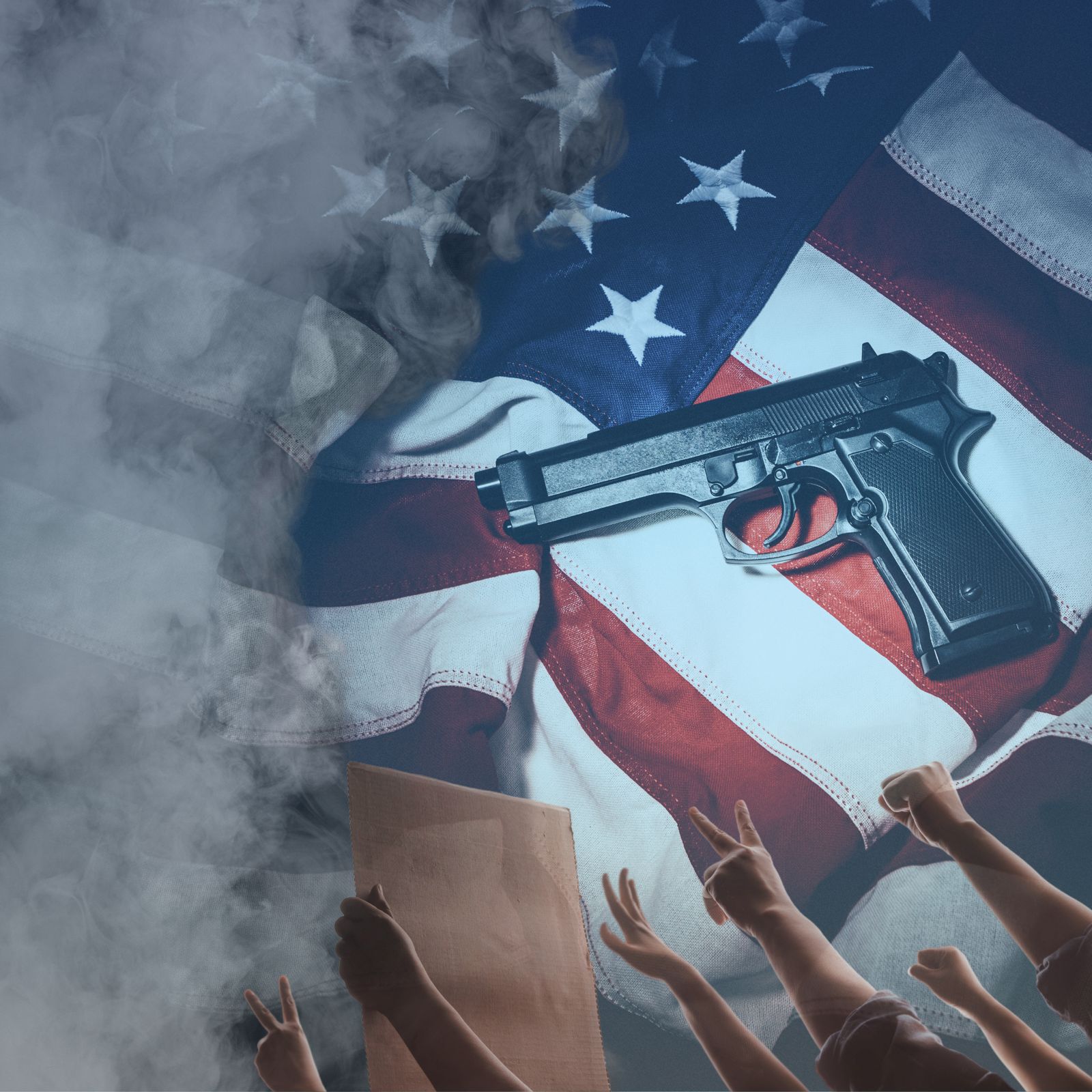
By Michelle Lee
Edited by Alejandro J. Ramos and Muhammad Hani Ahsan
Graphic by: Norie Wright and Arsh Naseer
Introduction
In recent years, the United States has seen a spike in gun-related violence and school shootings—heightening fear, anxiety, and trauma among many Americans. To enhance public safety, and reduce the risk of gun violence, the United States Congress is faced with the urgency to take serious action on gun laws. In this essay, we will primarily examine innovative, effective, and accountable interventions policymakers have implemented to address gun-related violence in the United States. Then, we will briefly explore the impact and paradoxes of intensified and excessive security on certain racial or ethnic groups—further reinforcing existing conflicts of systematic racism, racial bias, and educational inequalities.
I. Overview of the Gun Violence Problem
Guns are the leading cause of death for children and teens in America, with an overall surge since the COVID-19 pandemic.1 The rise in active shooter incidents and gun deaths in the United States has pushed public administrators to respond to public safety threats through innovative interventions. Between 2013 and 2022, Everytown documented a total of 720 instances of gun-related incidents occurring at preschools or K-12 schools. These incidents encompassed various types of gun violence, such as gun homicides, assaults, suicides and suicide attempts, unintentional shootings, and mass shootings. As shown in Figure 1, a whopping 63% of firearm-related fatalities occur in high schools.3 It is worth noting the significant surge in gun-related incidents starting in 2021 (254), reaching its peak in 2022 with 305 incidents in a year.4 These alarming numbers lead us to question the need for more stringent firearm legislation to reduce the social and economic burden associated with gun violence. The topic of gun violence demands the attention of public officials and administrators to weigh their answerability to the American public based on the concept that accountability is a relationship.5 While domestic gun violence remains a complex, urgent, and multifaceted problem, several notable stakeholders share accountability for addressing the public health issue:
- Youth Gun Owners: Studies have shown that most underage school shooters get legally registered guns from the students’ homes.6 Approximately 4.6 million children in the United States reside in homes where there is at least one firearm that is both loaded and not secured.7 Likewise, the heightened anxiety, stress, and isolation from the pandemic contributed to the adolescents’ likelihood to commit violence and misuse of firearms.8 This leads to questions about how easily firearms are accessed when left unsupervised and improperly stored in the student’s homes. Additionally, students who suffer from mental health issues, depressive thoughts, bullying, and anger management problems may resort to the use of handguns as outlets of aggression and violence.
- Educational institutions: Campuses must provide a safe environment with proper security infrastructure, measures, and policies to effectively respond to violence. The lack of metal detectors and adequate security measures can lead students to sneak guns into schools. The lack of support services, such as counseling, mental health services, and conflict resolution programs can delay treatment.
Figure 1: K-12 School Shooting School Level9
Figure 2: Incidents per year from 1966 – present10
II. Legislative & Executive Responses
There exists a common misconception that gun violence is not preventable but the epidemic public health crisis can be addressed through well-designed policies at three levels: legislative, executive, and budgetary. As the existing political polarization between advocates and opponents of gun control laws remains an ongoing debate, this leads to questions about the accessibility and exposure to gun violence in both public and private settings.
A. Legislative Approach
To properly define, the legislature makes policies, while the executive branch enforces them.11 To achieve effective regulatory administration, public administrators must follow three principles: “procedural fairness, substantive correctness of decisions, and achievement of public policy goals.”12 The same principles apply to the gun violence crisis existing in the United States. While there are ongoing controversies and debates regarding gun control, constitutional rights to bear arms, and overall concerns around public safety, gun violence should not be a legislative oversight. It should instead demand the urgent attention of the legislature to review or re-enact policies to reduce the incremental number of gun-related incidents.
On a legislative level, considerations have been made in an attempt to narrow the “Charleston loophole,” a 3-day gun provision that allows gun purchasers to sell their guns by default if a background check is not initiated within three business days.13 Many Senators have worked to reduce the background check system days from three to one day to prevent individuals from bypassing the law and finding legal loopholes to purchase guns with a criminal history. Reducing the time limit imposed pressure on the FBI to improve its background check system and promptly investigate and detect gun dealers with a criminal record.
Other endeavors of the legislature include the increased support of gun rights groups, such as Everytown for Gun Safety and the National Rifle Association (NRA) to regulate gun ownership, operate background checks, and review gun permits as a means of reducing gun violence.14
B. Executive Approach
The executive branch is responsible for the execution and implementation of laws and policies established by the legislative branch.15 Ghost guns are homemade, un-serialized, privately assembled guns that are untraceable and made to skirt the law and bypass background check systems.16 According to existing federal regulations, firearm manufacturers are legally required to mark or engrave unique serial codes for all firearms to facilitate firearm tracing. The implementation of such strict regulations is within the scope of the executive order to establish and maintain trust with the public by aligning with public safety practices and ensuring that citizens feel safe daily. Furthermore, this policy can keep adolescents from purchasing guns and keep gun violence under control when data indicates that most homicides are committed by young adults aged between 18 to 20 years old.17 This data demonstrates an evidence-based policymaking process for public administration to keep public safety a priority and gun violence at bay among adolescents.
III. Innovative Interventions and Policies/Innovative Practices Overview
With the rise in high-profile mass shootings and an increasingly unsafe school environment, policymakers have developed strategies for innovative interventions to decrease the risk of gun violence. There is intensive support and engagement of community members to make an impact on society’s welfare through innovative implementations. As safety and security become the primary goal and routine of regular school life, 43% of American schools have now incorporated a “panic button” or threat detection technology to improve crisis response.18 To further strengthen security, school districts have established a “locked door policy” in addition to metal detectors and have installed electronic door locks to accelerate shutdowns in the event of an active shooter. Though these preventative measures may provide temporary protection and moral support for students and staff, experts remain cynical as to how effectively and proactively they can prevent shootings from occurring.19
The installation and implementation of such preventative measures and safety barriers come with grave responsibilities. Even with the billions of dollars invested in innovative safety-related interventions, the frequency of school shootings and incidents of gun violence see no signs of regressing. While it is difficult to identify the root causes of gun violence despite the costs of school security enhancements, there is no doubt that the legislative and executive branches of government have experienced growing pressure to expand funding. Public investments and tight budgetary controls are primarily funded by “safety taxes” imposed on students to support safety initiatives.20 As gun violence is at an all-time high, the federal government is grappling with budgetary constraints as a disproportionate share of resources are allocated for effective gun violence prevention services such as the Bureau of Alcohol, Tobacco, Firearms and Explosives (ATF). It is not clear whether measures such as electronic doors, panic buttons, metal detectors, armed staff members, and safety taxes are cost-effective. Therefore, the government must align public investments with policy goals. A functional budgeting approach to reducing gun crime would be “zero-based budgeting” which rejects incrementalism and focuses on outlining expenditures based on urgency and priority.21 This budgeting method is results-oriented, evidence-based, and prevention-focused. It will save time and resources by allocating funding directly to programs and services that tackle gun violence, such as mental health services and school safety measures without investing in past programs that do not produce desired outcomes.
IV. Racial Disparities in Security Measures
Communities of color are disproportionately impacted today by gun-related violence. In the context of gun violence prevention, there exists incongruities and disparities related to security measures based on race and ethnicity. America had a long history of biased firearm regulations against Black Americans used to maintain the prevailing racial hierarchy or “racial order,” essentially denying them Second Amendment rights. Consequently, firearms and permits are more likely granted to White buyers than Black buyers—further heightening the barrier for the minority group to exercise their rights.22 It is observed that race is employed as a metric to determine and rely on protective measures, and strategically designed to keep systematic racism alive and make Black Americans feel powerless and defenseless. The American laws are built upon a series of repercussions of past doctrines and ideologies that “codified racial hierarchies” in an attempt to maintain social order, White supremacy, or a colonizer versus subordinate dynamic.23 Meanwhile, the aftermath is mirrored in the current discussion of gun violence and school shootings as we continue to see unequal practices and restrictive security established in predominantly Black institutions.24
Ironically, the aftermath of the Sandy Hook Elementary School shooting resulted in schools leaning towards the implementation of stricter surveillance practices in schools with a high proportion of Black, Hispanic, Asian, and Native American students—despite the shooter, Adam Lanza, being identified as White. The rigorous security measures encompass metal detectors, locked gates, clear bags, security cameras, armed staff members, random sweeps, and school police.25 As shown in Figure 3, White individuals were responsible for 79 out of the 148 mass shootings that occurred in the United States compared to 26 carried out by Black shooters from 1982 to October 2023. The data highlights inequities in education and discriminatory treatment in broader society. White Americans have less restricted legal access to firearms compared to Black Americans. On the other hand, equally strict preventative measures are not applied in schools with predominantly White students but are common practice in schools with predominantly nonwhite students. Therefore, public administrators should adhere to a consistent application of the same rigorous measures to maintain order employed by all schools. This supports the idea that systematic racism and racial bias continue to linger in administrative decision-making processes, which is consistent with the historical context of discriminatory U.S. gun legislation. To align with administrative ethics and public sector values, the government should offer a “race-neutral” approach when combating gun violence combined with evidence-based and data-driven to achieve racial fairness.26
Figure 327
Number of mass shootings in the United States between 1982 and October 2023, by shooter’s race or ethnicity28
Figure 3: Number of mass shootings in the United States between 1982 and October 2023, by shooter’s race or ethnicity
Conclusion
Policymakers can contribute to the prevention of gun violence in schools by enacting innovative interventions based on evidence-based policymaking data. Racial disparities in the harsh security techniques and surveillance implemented in schools also highlight the need for more equitable and inclusive school safety policies. Congress must work toward resolving legislative issues such as the “Charleston loophole” and implementing responsible legislation including gun safety training and background checks. The executive branch must ensure the implementation of existing laws, particularly the regulations around ghost guns. Zero-based budgeting can be used to fund programs, such as mental health support and security measures, to ensure efficiency in resource allocation and cost-effectiveness. However, gun laws must also account for a historical context of racism that often informs policymaking and implementation worsening inequities.
- Choi, Angela. 2023. “Children and Teens Are More Likely to Die by Guns Than Anything Else.” CNN Health. https://www.cnn.com/2023/03/29/health/us-children-gun-deaths-dg/index.html.
- Everytown Research & Policy. 2023. “How Can We Prevent Gun Violence in American Schools.” Everytown Research & Policy. https://everytownresearch.org/report/how-can-we-prevent-gun-violence-in-schools/.
- Riedman, David. 2023. “All Shootings at Schools From 1966-Present.” K-12 School Shooting Database. https://k12ssdb.org/all-shootings.
- Ibid.
- Kettl, Donald F. 2021. Politics of the Administrative Process. 8th ed. N.p.: SAGE Publications.
- Carter, Patricia, Matthew Zimmerman, and Robert Sokol. 2021. “Most School Shooters Get Their Guns from Home—and During the Pandemic, the Number of Firearms in Households with Teenagers Went Up.” University of Michigan School of Public Health. https://sph.umich.edu/pursuit/2021posts/most-school-shooters-gets-guns-from-home.html
- Everytown Research & Policy. 2023. “How Can We Prevent Gun Violence in American Schools.” Everytown Research & Policy. https://everytownresearch.org/report/how-can-we-prevent-gun-violence-in-schools/.
- Everytown Research & Policy. 2023. “How Can We Prevent Gun Violence in American Schools.” Everytown Research & Policy. https://everytownresearch.org/report/how-can-we-prevent-gun-violence-in-schools/.
- Riedman, David. 2023. “All Shootings at Schools From 1966-Present.” K-12 School Shooting Database. https://k12ssdb.org/all-shootings.
- Ibid. (FIGURE 2)
- Kettl, Donald F. 2021. Politics of the Administrative Process. 8th ed. N.p.: SAGE Publications.
- Ibid.
- Parsons, Chelsea. 2021. “Gun Violence Prevention Priorities for a New Congress and a New Administration.” American Progress. https://www.americanprogress.org/article/gun-violence-prevention-priorities-new-congress-new-administration/.
- Ibid.
- Kettl, Donald F. 2021. Politics of the Administrative Process. 8th ed. N.p.: SAGE Publications.
- Parsons, Chelsea. 2021. “Gun Violence Prevention Priorities for a New Congress and a New Administration.” American Progress. https://www.americanprogress.org/article/gun-violence-prevention-priorities-new-congress-new-administration/.
- Everytown Research & Policy. 2023. “How Can We Prevent Gun Violence in American Schools.” Everytown Research & Policy. https://everytownresearch.org/report/how-can-we-prevent-gun-violence-in-schools/.
- Mervosh, Sarah. 2023. “Panic Buttons, Classroom Locks: How Schools Have Boosted Security.” The New York Times. https://www.nytimes.com/2023/01/12/us/school-shootings-security.html.
- Ibid.
- Ibid.
- Kettl, Donald F. 2021. Politics of the Administrative Process. 8th ed. N.p.: SAGE Publications.
- Jewett, Peter I., Ryan E. Gangnon, Irwin Borowsky, Jamie Peterson, Emily M. Areba, Anthony Kiragu, and James Densley. 2022. “US Mass Public Shootings Since Columbine: Victims Per Incident by Race and Ethnicity of the Perpetrator.” Preventive Medicine. https://doi.org/10.1016/j.ypmed.2022.107176.
- Alexander, Jeffrey, and Camille Stivers. 2020. “Racial Bias: A Buried Cornerstone of the Administrative State.” Administration & Society 52 (10): 1470-1490. https://doi.org/10.1177/0095399720921508.
- Anderson, M. D. 2016. “When School Feels Like Prison.” The Atlantic. https://www.theatlantic.com/education/archive/2016/09/when-school-feels-like-prison/499556/.
- Ibid.
- Williams, Brian N., and Brenda Duckett. 2020. “At the Juncture of Administrative Evil and Administrative Racism: The Obstacles and Opportunities for Public Administrators in the United States to Uphold Civil Rights in the Twenty-First Century.” Public Administration Review 80 (6). 1038–1050. https://doi.org/10.1111/puar.13279.
- Statista. 2023. “Number of Mass Shootings in the United States Between 1982 and August 2023, by Shooter’s Race or Ethnicity.” Statista. https://www.statista.com/statistics/476456/mass-shootings-in-the-us-by-shooter-s-race/.
- Ibid.





